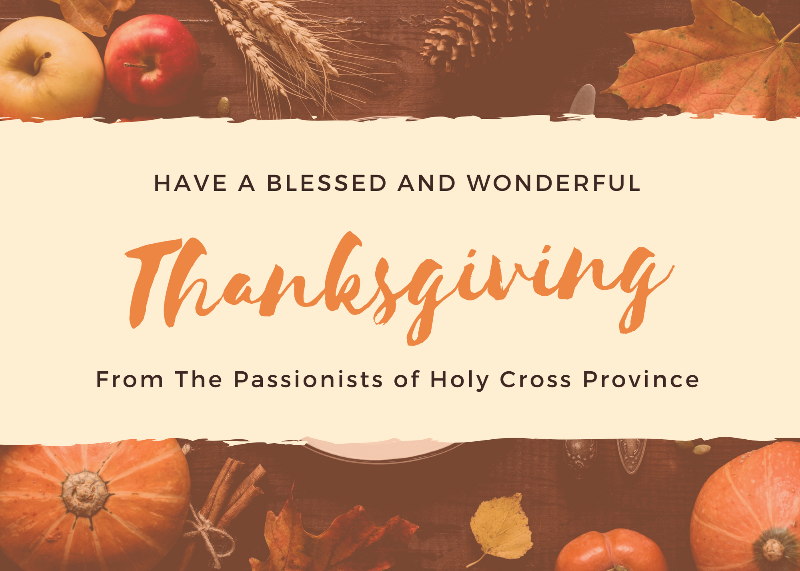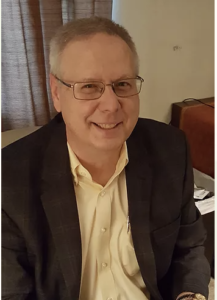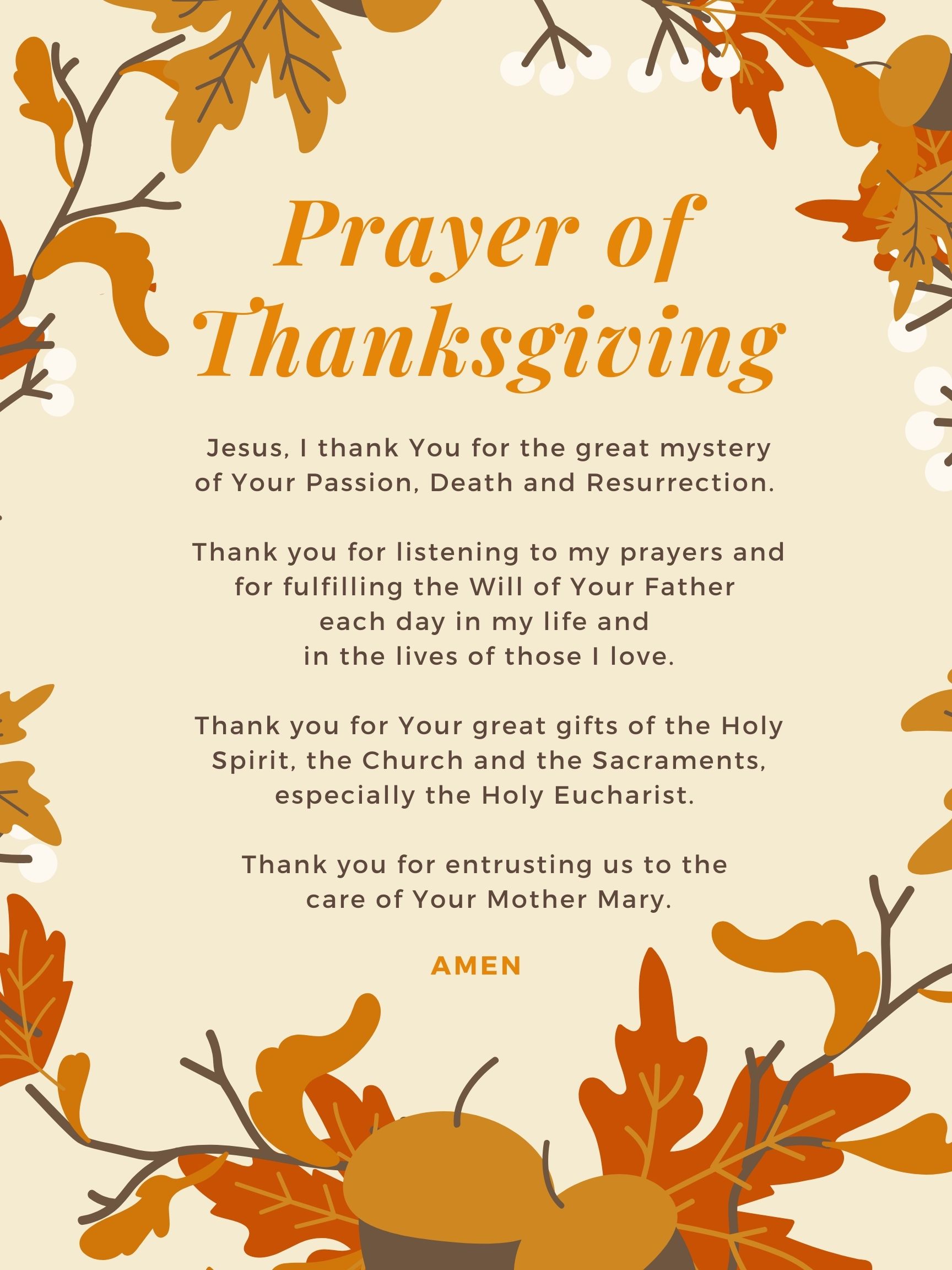
Communicating with Passion
November 19, 2020
IN THIS ISSUE
- Charism Formation Commission Update
- Online spiritual direction
- Transfomative Communities Series: Generative Designers of the Future (Part 5)
- A Prayer of Thanksgiving
Charism Formation Commission Update
By Marci Madary
Small but mighty, the Charism Formation Commission is busy taking the Project Proposals created at the 2019 Chapter and shepherding their fruition. Members Jean Bowler and Marci Madary, along with Vision Fulfillment facilitator Tim O’Brien, have been meeting monthly. If you are interested in joining the Charism Formation Commission, email Marci at [email protected].
The following are the list of proposals and the status of each.
Proposal #1 - Passionist Rule of Life for Laity
Using other religious communities as examples, this project recommends that the Passionist Rule be set out as a means for laity to integrate the Passionist Charism. In this sense, “rule” does not denote regulations, but rather a brief, clear and fundamental statement of principles that Paul of the Cross projected to his followers about living lives according to the Gospel.
We recommend that a task force be convened to undertake writing a Passionist Rule for Laity and that it be made available as part of the OME curriculum.
A committee is currently being formed to discuss and create a Lay Passionist Rule of Life. People on the committee are Terry McDevitt, Faith Offman, Capper Rademaker, Lissa Romell and Paul Wadell. Tim O’Brien is offering leadership to this committee.
Proposal #2 - Hybrid Retreats
A pool of resources is created to be used among retreat centers, identify certain retreat themes, what are good supplements for a team on the ground, resources from the Holy Cross Province Offices/ CTU/other Passionist Provinces, and identifying speakers who are versed in Passionist Charism and comfortable with the necessary technology.
We recommend that the PRCB gather a group of representatives from the various retreat centers to organize ideas and resources that can be shared.
Deacon James Anderson and the PRCB are in the process of assembling a working group to address this. They have asked for each retreat center to provide two representatives for the group along with a Provincial Council Liaison. The working group hopes to get itself organized and working in the near future.
Proposal #3 - Online Spiritual Direction
A standard practice of online spiritual direction be established with a specific pool of trained spiritual directors who are comfortable with this format. Because it is online, the spiritual directors can be located at various locations.
We recommend that Passionist spiritual directors gather to establish online spiritual direction guidelines as well as formatting., i.e. how people sign up, who ‘pairs’ spiritual and directees, how payment is handled, specific considerations, orientation session, etc.
An invitation for people to be a part of a group to work on the details to begin online spiritual direction was sent to the Passionist Family through the monthly Passionist newsletter and the biweekly Vision Fulfillment Newsletter. Marci Madary will offer leadership for this group.
Proposal #4 - Extended Learning of the Passionist Charism
Because the CTU Summer Institute needs to limit the number of people who can participate in person and the length of time, formation and education in the Passionist Charism needs to be expanded.
We recommend that OME works with CTU to find creative ways to engage people in learning, including using technology, about St. Paul of the Cross and the Passionist Charism in addition to the Summer Institute.
Because of the pandemic, much of this kind of expanded learning is already happening. Both Donald Senior, CP, and Don Webber, CP, are aware of the proposal.
Proposal #5 - New Employee Passionist Formation
While formation in the Passionist Charism is conducted for board members and employees in leadership, every employee in a Passionist ministry needs to be formed by the Passionist Charism in some degree to help sustain the Passionist culture.
We recommend that OME continue to develop a variety of Passionist Charism formation models that can be used with every new employee at a Passionist ministry.
Don Webber, CP, and OME are developing a program for charism formation for new employees of Passionist ministries.
Proposal #6 - Zoom Faith-sharing Meetings
This vehicle should be available for any Holy Cross Province member in leadership roles to empower faith sharing through Zoom to be provided by the Province. Individual proposals need to be submitted which should include group, individual invitees, purpose, and content. Expected duration, e.g. weekly, until a certain time.
Marci will send out an invitation for people to start a faith sharing Zoom group, let the Charism Formation Commission know, and we can help facilitate it. Jean Bowler will create a request form for a people interested in starting a Zoom faith sharing group. A facilitator for each group will be identified and offered training. Passionist Solidarity Network – Racial Justice Circle is an example of this already happening.
One of the Project Proposals from the Charism Formation Vision Fulfillment Team is creating a system to offer Spiritual Direction online.
“A standard practice of online spiritual direction be established with a specific pool of trained spiritual directors who are comfortable with this format. Because it is online, the spiritual directors can be located at various locations. We recommend that Passionist spiritual directors gather to establish online spiritual direction guidelines as well as formatting., i.e. how people sign up, who ‘pairs’ spiritual and directees, how payment is handled, specific considerations, orientation session, etc.“
If you are interested in being a part of a committee to create the structure that would facilitate online Spiritual Direction, please email Marci Madary: [email protected].

Transformative Communities Series:
Generative Designers of the Future
Part 5 of 5
By Mark Clarke
Part III: Action Plan and System Alignment
There is often a tendency to put tremendous energy and due diligence into setting the visionary course. Energy dissipates, however, as the group moves into establishing the action plan. If a group wants to have an impact and participate in the shifting societal process, it is crucial to have energy and passion for developing the action plan. The commitment to this phase of the process aligns the visionary aspiration with a committed implementation plan.
The creation of an action plan is a spiritual discipline that involves choosing appropriate priority actions to achieve a visionary direction. This spiritual path requires learning how to handle conflict and disappointment. The process also requires that difficult, sometimes tricky choices be made. It necessitates detachment from one's own will for a larger common good. Our individualistic society creates a real challenge to this type of commitment. At this point in the process, critical aspects are the prayerful reflection and seeking “oneness” of engagement as the congregation moves into the future.
The action plan defines the key priorities and initiatives crucial to achieving the visionary direction. The first step in creating a plan is assessing the current community assets needed to accomplish the vision as well as its challenges. It involves establishing initiatives, for example, that strengthen the formation, infrastructure, fiscal viability, and human resources to achieve the vision.
In Daniel Christian Wahl’s book, Designing Regenerative Culture, he affirms the critical importance of establishing an action plan when he states, “by exploring the potential feedback loops, limits, dynamics and key relationships within the system we can move to a deeper questioning in searching of organizing principles and policies that structure the system and drive its behavior.”11
The creation of a bold vision leads to asking four vital questions in the development of an effective action plan.
- What are aspects of our culture that need affirmation and change to achieve the visionary direction?
- What are the key activities, structures, and current initiatives that no longer serve the larger purpose?
- What are the current strengths and capacities within the system that are important to continue nurturing and developing to implement the direction?
- What are new initiatives, structures, collaborative relationships that are vital to implementing the vision?
System Alignment
The final step is aligning the entire system to the direction and implementation. It is critical to define the vital role of each area and staff member in achieving the visionary course. The alignment of the system builds ownership, investment, and creative imagination in the implementation process.
The alignment of the structure focuses on all aspects of the structures like ongoing formation, advancement, finances, human resources, etc. so that all understand their role concerning the community key priorities.
Defining the human, financial, and needed the capacity to implement the vision is essential. The following are some important questions to reflect upon in the system alignment stage.
- What capacities no longer serve our purpose, and what new skills or capabilities do we need to develop within our leadership and staff?
- How do we deepen the collaboration and relationships among our departments and partners to achieve the vision?
- Do we need to establish new partners if so with whom and for what?
- How is our current structure supportive of the vision, and what aspects need to be adapted to strengthen the achievement of the visionary direction?
System alignment is often overlooked, yet it is a vital segment of the planning process. There is a tendency to believe the current structure and capabilities are sufficient for the new plan. Imperative for achieving a bold direction, the current system often needs fresh ideas and adaptation.
Summary
Carl Jung stated, “Your vision will become clear only when you can look into your heart. Who looks outside, dreams, who looks inside awakes.”12 The transformative community walks a sacred path when it enters into its collective heart space to awaken its visionary aspiration. As a group walks the spiritual journey reflecting on the trends, developing a visionary direction, planning for action, and establishing alignment, they become like gold tested in fire. They create as Acts of the Apostles describes, “The community of believers were of one heart and mind...”13 The commitment to this process deepens the bonds of relationship and connectivity for achieving the desired future grounded in mutual trust, working through differences, and unfolding spirit within the individuals and groups. As Amelia Earhart stated, “The most difficult thing is the decision to act. The rest is merely tenacity. “14
11 Wahl. 88
12 Storm, Laura Hutchins Giles. REGENERATIVE LEADERSHIP: the Dna of Life-Affirming 21st Century Organizations. Wordzworth Publishing, 2019. Print. 118
13 NAB, Acts 4:32
14 Brinkley, Douglas. American Moonshot: John F. Kennedy and the Great Space Race. HarperCollins Canada,
Transformative Communities Series: Generative Designers of the Future
 Author and consultant, Mark Clarke, is a Senior Consultant for CommunityWorks, Inc. He is available for consultation and welcomes a conversation to discuss your thoughts and questions about his writings.
Author and consultant, Mark Clarke, is a Senior Consultant for CommunityWorks, Inc. He is available for consultation and welcomes a conversation to discuss your thoughts and questions about his writings.
For more information about using his article and concepts, please contact him at [email protected] or call 616-550-0083. Additional articles are available on the CommunityWorks, Inc., website: www.cworksindy.com.
Holy Cross Province Vision Statement
Guided by the Holy Spirit and the signs of the times,
we create and carry out ministry that reaches
the suffering of today and form community
that spiritually nourishes the
Passionist Family of Holy Cross Province.

If you would like to share your thoughts, ideas or reactions from anything in this newsletter, we would love to hear from you!
Send your thoughts to
[email protected]
Copyright © 2020 All rights reserved.
